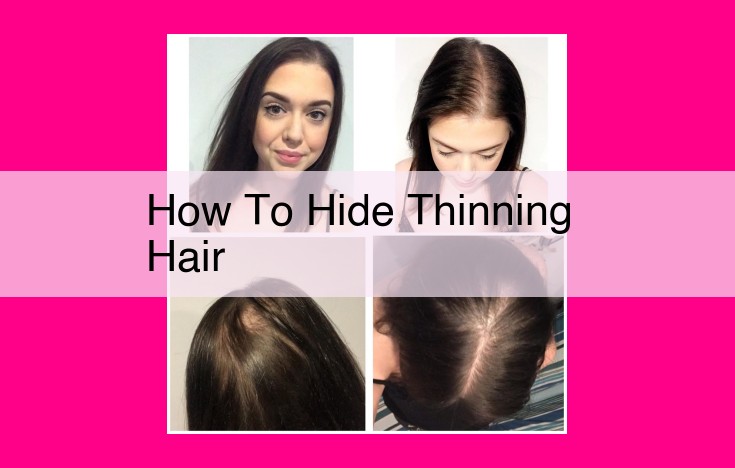Comprehensive Guide To Combating Thinning Hair: Treatments, Products, And Solutions

To combat thinning hair, utilize volumizing shampoos and conditioners, or consider hair thickeners and volumizing mousses. Extensions, toppers, wigs, and hairpieces can provide instant coverage. If medications are desired, minoxidil and finasteride are options, while platelet-rich plasma therapy and laser therapy offer alternative treatments. Understanding the underlying causes of hair loss, such as androgenetic alopecia, alopecia areata, or telogen effluvium, can guide the most effective approach to managing thinning hair.
Discover the Ultimate Hair Thickening Guide
For those seeking luscious, voluminous locks, uncovering the secrets to hair thickening is a quest worth embarking on. From volumizing shampoos to extensions and hairpieces, this comprehensive guide will empower you with the knowledge and strategies to achieve your hair goals.
Volumizing Products: Your Hair’s Best Friend
Volumizing shampoos and conditioners are the foundation for thicker-looking hair. They contain ingredients like keratin and collagen, which plump up hair shafts and create an illusion of volume. Styling products like mousses and gels provide extra lift, helping hair hold its shape and defy gravity.
Hair Thickeners: A Quick Boost for Instant Results
Hair thickeners come in various forms, including sprays, powders, and creams. They work by temporarily coating hair strands, making them appear thicker and fuller. Root touch-up sprays are a lifesaver for concealing sparse areas and creating the illusion of a fuller hairline. Volumizing mousses offer a long-lasting hold, boosting hair from the roots and giving it a natural-looking lift.
Hair Extensions, Toppers, and More: Solutions for Every Need
For those seeking more dramatic transformations, hair extensions, toppers, wigs, and hairpieces offer a customizable solution. Hair extensions are individual strands or wefts that are attached to existing hair, increasing length and volume. Toppers are smaller pieces that cover the crown or specific areas, providing instant volume and coverage. Wigs and hairpieces offer complete coverage and a wide range of styles, allowing you to experiment with different looks.
Medications and Treatments for Hair Loss
If you’re struggling with hair thinning or loss, understanding the available treatments and medications can empower you in your journey toward thicker, fuller hair.
Minoxidil and Finasteride: Medical Interventions
Minoxidil, also known as Rogaine, is a topical medication that stimulates hair growth by increasing blood flow to the scalp. Finasteride, an oral medication, is used to prevent further androgenetic alopecia, the most common type of hair loss. It works by blocking the hormone DHT, which can cause hair follicles to shrink and thin out.
Platelet-Rich Plasma Therapy and Laser Therapy
In platelet-rich plasma (PRP) therapy, a concentrated portion of your own blood platelets is injected into the scalp. These platelets contain growth factors, which promote hair growth and strengthen hair follicles. Laser therapy involves the use of low-level lasers to stimulate blood circulation and promote cellular activity in the scalp. While both therapies have shown promising results, further research is needed to fully understand their long-term effectiveness.
Scalp Micropigmentation: A Cosmetic Solution
Scalp micropigmentation is a cosmetic procedure that involves tattooing tiny dots of pigment into the scalp. This technique creates the illusion of thicker hair, concealing areas of hair loss. It is a permanent solution, but it may require multiple sessions to achieve the desired results. It’s important to choose a qualified professional to ensure natural-looking results.
Choosing the Right Treatment
The best hair loss treatment depends on the individual case. It’s essential to consult with a board-certified dermatologist to determine the cause of your hair loss and discuss the most suitable treatment options. With the right guidance and treatment plan, you can improve your hair growth, boost your confidence, and regain a fuller head of hair.
Understanding Hair Loss: Common Causes
Hair loss can be a distressing experience, affecting both men and women. While there are many possible causes, three of the most common are androgenetic alopecia, alopecia areata, and telogen effluvium .
Androgenetic Alopecia
This type of hair loss is often referred to as male-pattern baldness or female-pattern hair loss, as it is influenced by both genetics and hormones. In androgenetic alopecia, the hair follicles become increasingly smaller and weaker over time due to the effects of dihydrotestosterone (_DHT), a hormone derived from testosterone. DHT can shrink the hair follicles, resulting in finer, shorter hair that eventually stops growing altogether.
Alopecia Areata
This is an autoimmune condition that causes the immune system to attack the hair follicles, leading to hair loss in well-defined patches. The exact cause of alopecia areata is unknown, but it is thought to be related to genetic and environmental factors. While alopecia areata can affect anyone, it typically begins in childhood or early adulthood.
Telogen Effluvium
Unlike androgenetic alopecia and alopecia areata, which are permanent forms of hair loss, telogen effluvium is a temporary condition characterized by excessive hair shedding that occurs over a period of several months. It is often triggered by stressful events, illness, or changes in medication. The good news is that telogen effluvium is usually reversible once the underlying cause is addressed.
If you are experiencing hair loss, it is important to consult with a dermatologist to determine the underlying cause and receive appropriate treatment.